
Lea-Francis
Encyclopedia

History
Richard Henry Lea and Graham Inglesby Francis started the business in CoventryCoventry
Coventry is a city and metropolitan borough in the county of West Midlands in England. Coventry is the 9th largest city in England and the 11th largest in the United Kingdom. It is also the second largest city in the English Midlands, after Birmingham, with a population of 300,848, although...
in 1895. They branched out into car manufacture in 1903 and motor cycles in 1911. Lea-Francis built cars, under licence, for the Singer
Singer (car)
Singer was an automobile company founded in 1905 in Coventry, England. It was acquired by the Rootes Group of the United Kingdom in 1956, who continued the brand until 1970...
company. In 1919 they started to build their own cars from bought-in components.
From 1922 Lea-Francis had a tie up with Vulcan of Southport sharing manufacturing and dealers. Vulcan supplied bodies to Lea-Francis and in return got gearboxes and steering gear. Two six-cylinder Vulcan designed (and made) cars were marketed as Lea-Francis 14/40 and 16/60 as well as Vulcans. The association finished in 1928 when Vulcan stopped making cars.
A sporting image began to appear from about 1925 leading to models such as the Hyper and the Ace of Spades. The Hyper (also called the S Type) was the first British supercharged production car with a 1.5 litre Meadows
Henry Meadows
Henry Meadows of Wolverhampton, England were major suppliers of engines and transmissions, to the smaller companies in the British motor industry...
engine, and in 1928 a Lea-Francis Hyper won the Ulster TT, a 30-lap race on the 13.5 miles (21.7 km) Ards circuit on the roads of Northern Ireland in the hands of legendary race car driver, Kaye Don. The race was watched by a record 250,000 spectators, and the victory placed Lea-Francis firmly on the map.
The company was re-formed in 1937 under the chairmanship of George Leek with other ex-Riley men such as R.H. Rose who designed a new engine for Lea-Francis which had a similar layout to the Riley 12/4. The 12 hp and the 14 hp (actually 12.9 hp) were introduced in 1937 and continued until the start of the war in 1939 when production ceased and the factory concentrated on manufacturing for the war effort.
Post-war car production commenced in 1946 with updated vehicles based on the pre-war designs. The 14 hp Saloon and Sports were luxurious and sporty vehicles, and were popular, if expensive. Eventually an improved chassis with independent front suspension and hydraulic brakes was introduced across the range and in 1950 the 18 h.p. saloon and 2½ litre Sports, both with the more powerful 2½ litre engine, were introduced.
The company had a chequered history with some notable motor cycles and cars but financial difficulties regularly arising. The Hillfields site was abandoned in 1937 when it was sold by the receiver and a new company, under a slightly different name moved to Much Park Street in Coventry. It survived there until 1963 when the company was finally wound up.
The motor manufacturing parts of the company passed into the hands of the Receiver in 1963 leaving Lea-Francis to continue with their engineering business.
A total of almost 10,000 Lea-Francis vehicles were made until production ceased after the 1960 Lea-Francis Lynx failed to capture the buying public's attention. The Lea-Francis name and the assets of the company were purchased by Barrie Price who continues to provide service and spares for the surviving cars, and has also built a number of "modern" Lea-Francis motor cars reviving the model name "Ace of Spades."
In 1998 it was hoped that the Lea-Francis name might yet be seen again on the road when a new Lea-Francis sports car, the 30/230 to a design by James Randle, was shown at the Motor Show. Only a prototype was built before the project had to be abandoned.
Lea-Francis car models
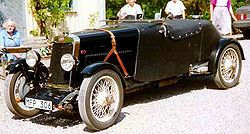
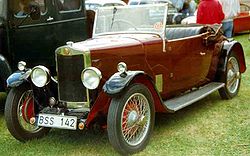
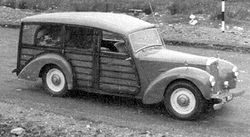
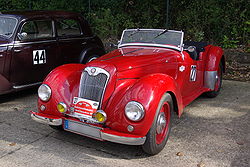
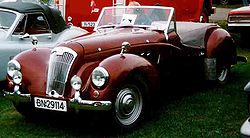
| Model Name | Engine | Year | Production |
|---|---|---|---|
| 15 | 3500 cc 3 cylinder | 1905–1906 | |
| 13.9 | 2297 cc inline 4 | 1920 | |
| 11.9 | 1944 cc inline 4 | 1920–1922 | |
| Nine (Type C) | 1075 cc inline 4 | 1920–1922 | |
| 10 and 12 (Types D to O) | 1247 or 1496 cc inline 4 | 1923–1930 | 2350 |
| 12 (Types P to W) | 1496 cc inline 4 | 1927–1935 | 1700 |
| 14/40 (and Type T) | 1696 cc inline 6 | 1927–1929 | 350 |
| 16/60 | 1990 cc inline 6 | 1928–1929 | 67 |
| Hyper 1.5 Litre Supercharged (Type S) | 1496 cc inline 4 | 1928–1931 | 185 |
| 2 Litre Ace of Spades | 1991/2244 cc inline 6 | 1930–1936 | 67 |
| 12 and 13 | 1496/1629 cc inline 4 | 1938–1940 | 83 |
| 12 | 1496 cc inline 4 | 1946–1947 | 13 |
| 14 | 1767 cc inline 4 | 1946–1954 | 2133 |
| 14 estate | 1767 cc inline 4 | 1946–1953 | 916 |
| 14 Sport | 1767 cc inline 4 | 1947–1949 | 118 |
| 14/70 | 1767 cc inline 4 | 1948–1951 | 162 |
| 18 | 2496 cc inline 4 | 1949–1954 | 69 |
| 2.5 Litre | 2496 cc inline 4 | 1949–1953 | 77 |
| Lynx | 2553 cc inline 6 | 1960 | 3 |
| Ace of Spades | Jaguar inline 6 | 1980–1990 | 6 |
Today the Lea-Francis Owners' Club has an ever growing membership of around 340 members who own around 420 vehicles. There are doubtless more Lea-Francis vehicles somewhere in the world, as the car was successfully exported in a number of markets.

